Web triggers global renaissance of Korean Wave

Black Eyed Peas’ will.i.am., left, began working with girl group 2NE1, right, after seeing them on YouTube. Provided by Universal Music Korea [JoongAng Ilbo]
If television was the medium that helped spread Korean soaps across Asia 10 years ago, then the World Wide Web is showing how it can perform more of a comprehensive service for K-pop by connecting artists, fans and industry players from continent to continent.
Black Eyed Peas’ front man will.i.am began working on an album with K-pop outfit 2NE1 last year that is destined for the U.S. market after the Los Angeles-based music producer saw the four girls performing songs on YouTube, the world’s largest video-sharing Web site.
Now file-sharing Web sites and other sites of a similar ilk are helping spearhead the renaissance of the Hallyu, or Korean Wave, on a larger scale.
“YouTube and similar Web sites that let you watch music video clips definitely play a decisive role [in promoting K-pop],” said Hong Seok-kyung, a professor of communications at the University of Bordeaux in France.
Hong’s recent thesis claims that the resurgent Korean Wave is largely based on Internet fandom, which is more spontaneous and prevalent than the previous drama-oriented flood of interest in cultural exports from the country.

According to Hong, the current K-pop craze in Europe, often dubbed the new Korean Wave, originates from European fans of Japanese manga comics.
“They were seeking something new and that’s what made them move onto Korean drama series from manga. Korean dramas led them to discover K-pop,” wrote Hong, who began researching the Korean Wave in France three years ago.
Susan Kang, founder of Soompi.com, one of the longest-running K-pop Web sites in California, agrees.
“It is a natural progression,” she wrote in an e-mail. “People hear the songs in the dramas, buy the original soundtracks and become interested in other K-pop artists.”
Kang launched Soompi.com in 1998 as a personal fan page and developed it to include all the latest news about K-pop and K-drama on a real-time basis. Korean company Enswers Inc. acquired it in February and made her its chief publicist.

Web sites Soompi.com, above, and Allkpop.com are two main contributors to the spread of Korean culture to American and European fans. Captured from each Web site
Soompi.com has eight full-time staff members as well as 30 contract writers from all over the world. They provide subtitles for Korean dramas, among other duties.
“For the drama ‘SungKyunKwan Scandal,’ Soompi fans put together English subtitles for every episode and shared these with other people through the forums,” said Kang.
But Korea does not seem well prepared to cash in on this new rise of Korean cultural content overseas. Fans complain that there are not enough distribution channels for them to access their favorite shows or songs, leading many to resort to illegal downloads.
“There aren’t really any legal ways to download Korean content online, so I use sites like BitTorrent to get the material I want,” said Hong Kong-based fan Bryant Chan, a graduate of the Tisch School of the Arts at New York University.
“Basically, in the U.S, it’s hard to get Korean shows legally. If you’re willing to pirate, then it’s easy.”
Like Chan, K-pop fans are still having a hard time finding ways to purchase merchandise and albums. More than 8,000 posts asking where they could purchase K-pop CDs and mp3 files were found on Yahoo! Answers in August. Some of the postings were uploaded as early as 2007.
Cho Yoon-sun, a Grand National Party lawmaker, said that even trimming the number of illegal downloads by 10 percent could generate revenue of 9 trillion won ($8.2 billion).

The KAPP, which manages the distribution of Korean songs online, signed a deal with Soribada, a local music portal, in December 2009 to provide 170,000 K-pop songs to Apple’s iTunes store. It was a late entry into the world’s biggest music store, considering that the genre started to become popular overseas about five years earlier.
“Digital music files have their own common numbers, but the KAPP didn’t have such numbers, which made it impossible to directly provide digital music files to the iTunes store, which is weird,” said the insider, who requested anonymity.
The KAPP said iTunes serves a greater role than just racking up online sales. “Simply by virtue of selling music there, we can promote K-pop,” said Kim Gye-young at the KAPP.
“But we are now working on ways to provide music independently in the near future without the use of Soribada.”
By Sung So-young [so@joongang.co.kr]










with the Korea JoongAng Daily
To write comments, please log in to one of the accounts.
Standards Board Policy (0/250자)